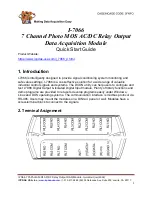
Welcome
R&S
®
OSP
11
User Manual 1178.7100.02 ─ 05
NOTICE
Potential risks of damage. Could result in damage to the supported product or to other
property.
1.1.5
Restrictions on Opening a Switch Unit
Do not open an R&S
OSP, to avoid personal injury and instrument damage.
●
If opening is required for mounting a module (see
), let Rohde
&
Schwarz
service personnel mount this module.
●
If opening is not required for mounting a module, follow the mounting instructions in
Chapter 2.4, "Mounting a Module"
1.1.6
Safety Considerations for SSRs
Risk of injury and damage due to inappropriate SSR usage
At power loss, solid-state relays (SSRs) have
no defined
switching state. Hence, other
, if there is a malfunction (for example,
missing supply voltage), typically the SSR ports go to a high-impedance state. But the
relay does not actively switch off a connected load. This failure can lead to a risk of
personal injury and damage of equipment.
To prevent this risk, you must implement a dedicated concept for failsafe operation of
your system in a competent manner.
Risk of damage due to inappropriate SSR usage
Solid-state relays (SSRs) are intended for high-frequency and high-speed switching,
but their semiconductor elements are damaged easily by excess current, voltage
peaks or a short circuit. Hence, inappropriate conditions or usage can damage SSRs
or connected components and lead to associated problems.
To prevent this risk, avoid excess current, voltage peaks and short circuits.
Risk of SSR damage due to inappropriate operating conditions
Solid-state relays (SSRs) for RF applications are intended for switching low powers. To
avoid damage due to overload, refer to the operating conditions according to the data
sheet.
Monostable vs. failsafe
Without power, a solid-state relay (SSR) quits operating as a switch:
●
It is in a
non-defined
high-impedance state
●
It does not have any stable switching state
Safety and Regulatory Information












































